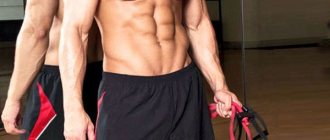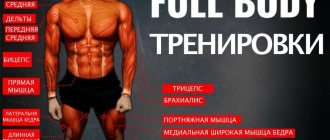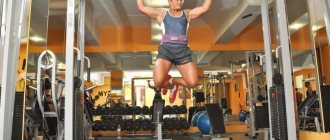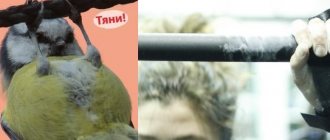How many reps to do in a weight approach?
There is an opinion that to gain mass it is best to do 6-12 repetitions. This rep range actually promotes muscle fiber hypertrophy. However, this theory is already more than 60 years old and it is very conditional. A number of modern scientific studies have established that for muscle growth the number of repetitions is not as important as the time the muscles are under load, a gradual increase in working weights and training volume.
So, to increase muscle mass, it is necessary that each approach last about 30 seconds and end 1-2 repetitions before muscle failure. That is, if you perform an exercise with a very light weight for 30 seconds, it is unlikely that you will be able to build muscle mass. The working weight should be approximately 65-80% of one repetition maximum (1RM). That is why most often the answer to the question of how many repetitions to do is 6-12 repetitions. This is how many repetitions you can do in about 30 seconds with a working weight of 65-80% of 1RM.
However, in order to constantly progress, it is necessary to gradually increase the load. Without progression of the load, you will stagnate in one place. Therefore, in your next workout, try to either increase the working weight a little, or do more repetitions or sets. The main thing is not everything at once. The load must be increased gradually, otherwise you will drive yourself into a state of overtraining.
That is why experienced athletes keep a training diary, which allows them to effectively adhere to the principle of progression and periodization of loads. Any training program can be much more effective if you keep a training diary. Conversely, even the most effective training program may not meet your expectations without a diary. Draw the right conclusions.
Terrain training program for men
This weekly program is built on the split principle, that is, only one muscle group is trained on one day, which will allow you to perform a high-quality workout and fully recover for the next one.
Workout 1: Chest
This set of exercises targets both your upper, lower, and middle pecs—while also targeting your shoulders and triceps—so you can begin to build a bigger, wider, more defined chest.
1A Dumbbell Bench Press
5 sets of 8 reps Rest 30 sec.
Benefits : Works your chest, shoulders and triceps.
Technique : Lie on a horizontal bench, holding a dumbbell in each hand and placing your feet on the floor. Push the weight straight up, straightening your arms, then return to the starting position.
1B Pullover with dumbbell
Sets 5 Reps 8 Rest 60 sec.
Benefit : Opens the chest, fully stretching the pectoral muscles at the bottom of the range of motion with each repetition.
Technique : Lie on a horizontal bench with your head on it and your feet flat on the floor. Hold the dumbbell with both hands above your chest, then lower it behind your head. Forcefully return the dumbbell to its original position from behind your head and take the starting position.
2A Dumbbell bench press with a narrow parallel grip on an incline bench
Sets 4 Reps 10 Rest 30 sec.
Benefits : The head-up incline press focuses the load on the upper pecs.
Technique : Lie on an incline bench with a dumbbell in each hand near your shoulders, push your chest up and feet firmly on the floor. Press the weight vertically upward until your elbows are fully extended and return to the starting position.
2B Dumbbell flyes lying at an upward angle
Sets 4 Reps 10 Rest 60 sec.
Benefit : Isolates the pectoral muscles, forcing them to do all the work.
Technique : Lie on an incline bench with dumbbells in each hand. Straighten your arms, palms facing each other. Keeping your elbows slightly bent, lower the dumbbells to your sides, then squeeze your chest muscles to return to the starting position.
3A Bringing hands together in crossover
Sets 3 Reps 12 Rest 30 sec.
Benefit : Works the middle portion of the pectoral muscles and the front of the shoulders.
Technique : Stand in the center of the machine's frame, holding a D-handle in each hand. Keeping your arms slightly bent and your chest up, slowly lower your arms in an arcing pattern, bringing them together in front of your chest. Reverse the movement.
3B Crossover on block
Sets 3 Reps 12 Rest 60 sec.
Benefit : Also loads the middle part of the chest, making your pectoral muscles more prominent.
Technique : Same as crossover, but lower your arms until they meet at the top of your thighs. Try to stretch your arms as best as possible at the top point of the amplitude.
Workout 2: Back and Shoulders
The first superset will work your upper and middle back to make it wider. Next up are two shoulder exercises designed to increase the size of all parts of the shoulder muscles before you finish off tired muscles with two often overlooked exercises.
1A Vertical thrust
Sets 5 Reps 8 Rest 30 sec.
Benefit : Works the lats, making your back appear wider so your waist appears narrower.
Technique : Grab the handle with a wide, straight grip. Squeeze your shoulder blades together, push your chest up and pull the handle down to chin level. Return to the starting position.
1B Rowing
Sets 5 Reps 8 Rest 60 sec.
Benefit : The machine ensures proper technique for performing the exercise, so use heavier weights, watch your form, and focus on contracting your upper back muscles powerfully with each rep.
Technique : Squeeze the handle with both hands, palms facing each other. Keeping your back straight, pull the handle towards you, starting the movement with your elbows. Return to the starting position.
2B Army dumbbell press
Sets 4 Reps 10 Rest 30 sec.
Benefit : Allows you to work the muscles of each shoulder separately, you can squeeze the weight through the full range of motion. Perform each repetition slowly and under control.
Technique : Stand up straight, holding a dumbbell in each hand at shoulder level, palms facing forward. Press the dumbbells vertically upward until your arms are fully straightened, and return to the starting position.
2B Dumbbell swings to the sides
Sets 4 Reps 10 Rest 60 sec.
Benefit : Works the middle delts, increasing the width of the body.
Technique : Stand up straight with dumbbells in both hands. Lift the weight up through your sides, starting at your elbows. Lower your arms down in a controlled manner.
3A Pull-down of the upper block with straight arms
Sets 3 Reps 12 Rest 30 sec.
Benefit : You'll again work your lats and the front of your shoulders, but don't use too much weight: strict technique is essential to preventing injury.
Technique : Grasp the straight handle with an overhand grip with straight arms. Push your chest up and pull the handle down in a slightly curved path toward the front of your thighs, and slowly return to the starting position.
3B Pull block to face
Sets 3 Reps 12 Rest 60 sec.
Benefits : This exercise activates the often-overlooked rear delts, and by adding volume to them, helps create that coveted inverted triangle shape.
Technique : Stand up straight and grasp the double rope handle attached to the overhead pulley with straight arms. Raising your chest up, pull the ends of the handle towards your face on both sides, then return to the starting position.
Weight loss training program for men
The Ultimate Chest Exercise: Build Massive Chest in 8 Weeks.
A monthly arm workout that will help you build biceps and triceps in 30 days.
Workout 3: Biceps and Triceps
This set of exercises alternates between working your biceps and triceps, allowing you to build muscle in your arms while saving time and allowing for efficient recovery between exercises so you can give it your all in every set for maximum muscle gains.
1A Close grip bench press
Sets 5 Reps 8 Rest 30 sec.
Benefit : A narrow grip shifts the load from the pectoral muscles to the triceps.
Technique : Lie down with a shoulder-width grip on the bar. Lower the bar to your chest, then press the weight back up.
1B Vertical row with reverse grip
Sets 5 Reps 8 Rest 60 sec.
Benefit : Using this grip works the biceps more intensely than with a straight grip.
Technique : Grab the handle with an underhand grip, shoulder-width apart. Squeeze your shoulder blades together, push your chest up, and pull the handle down in front of you until you reach your upper chest. Return to the starting position.
2A French press EZ-bar while standing
Sets 4 Reps 10 Rest 30 sec.
Benefit : Isolates the triceps and works them through their full range of motion. Don't sacrifice proper technique for heavier weights.
Technique : Stand up straight, holding the EZ bar with your arms straight above your head, shoulder-width apart. Lower the barbell behind your head, then straighten your arms, returning to the starting position.
2B Raising the EZ-bar for biceps
Sets 4 Reps 10 Rest 60 sec.
Benefit : Intensively works the biceps without putting extra strain on the wrists.
Technique : Stand up straight and grab the EZ bar with a reverse grip, shoulder-width apart. Raise the barbell up to shoulder level, pause, then lower the barbell down to the starting position under control. Squeeze your biceps at the top and stretch your triceps at the bottom with each rep.
3A Block press for triceps
Sets 3 Reps 12 Rest 30 sec.
Benefit : The block helps maintain tension in the triceps during both the downward and upward movement of each repetition, so that the muscles remain contracted the entire time.
Technique : Stand facing a pulley machine, grasping the double cable handle with both hands with your palms facing each other. Press your elbows to your sides and pull the handle down until your arms are fully straightened and return to the starting position.
How many reps to do for relief?
Many people are concerned about the question of how many repetitions to do for relief. It’s worth noting right away that the issue of muscle definition has more to do with nutrition than with training. In order to improve muscle definition, it is necessary to create a small calorie deficit in the body and eliminate sweets, smoked foods and other unhealthy foods. However, when training for terrain, it is traditional to perform more repetitions with light weights. High reps increase the amount of time your muscles are under tension, which improves endurance and helps you burn more calories. Thus, the question “how many repetitions should I do for relief?” is more correctly rephrased as “how many repetitions should I do for endurance?”
As mentioned above, to improve muscle endurance, it is necessary to perform a large number of repetitions in each approach (12 and above). This number of repetitions helps not only to increase endurance, but also to improve muscle definition, subject to proper nutrition, of course. How many repetitions do you think should be done for mass, strength and muscle definition? Write your answer in the comments.
When do you need terrain training?
It’s worth starting by defining the task - whether there is a need for such training. If you have only recently started training and do not have enough experience, then the “raw material” (raw mass) is most likely not enough.
Drying can only aggravate the situation - lead to “burning” of existing muscles. In the case when the body has gained a sufficient amount of muscle mass and fat deposits, the process will come in handy.
Multi-repetition
So, high-repetition exercises are exercises for a large number of repetitions, performed with light weight and at a fast pace, with minimal rest. Because of this, strength training with multiple repetitions begins to resemble cardio : the heart beats like crazy, sweat flows in a stream - accordingly, the pulse quickens and the fat burning process seems to begin (for more information about the fat burning process, read the article How to burn fat? .
If you don’t eat enough, you won’t gain muscle mass (your butt will remain the same size, no matter how hard you try), you won’t particularly increase your strength, but your body will gain tone and lose a couple of kilos. It seems that this is our goal, and that means we will do a huge number of repetitions as usual! But no. A huge disadvantage of multi-repetition exercises is the body’s rapid adaptation to it . This happens because with such training it is very difficult to lift the working weight, because The body already has a hard time training, and in the end you remain at the same level.
The logic of high-repetition enthusiasts is simple - “I will train my muscles every day with light weights, burn more calories and lose weight.” But in fact, you go to the gym, swing dumbbells there, spend an hour every day, and even the most miserable meal of the day negates the kcal spent in the heat of multiple repetitions. In decent gyms, such trainees are caught and gently explained to them about overtraining and the importance of other types of load. In very good ones, they hand you a barbell and teach you how to lift it. In indecent ones, people themselves come to the understanding that doing multiple repetitions every day is ineffective. As a rule, after suffering from a long-term cold, fighting swelling, and taking a couple of courses of expensive immunomodulatory pills.
Gluten: friend or foe?
Recommendations for training and nutrition for relief
So, nutrition is a very important component of training aimed at creating relief. The main principle of the diet will be to reduce the amount of carbohydrates. The main emphasis in the diet should be on protein. Its daily amount should be 4-5 grams per kilogram of the athlete’s weight. During relief work, only complex carbohydrates can be consumed. You need to start with 2 grams of carbohydrates per 1 kilogram of the athlete’s weight, then, if necessary, reduce to one gram. To create a high-quality sculpted body, there are no differences in nutrition between men and women.
Detailed menu for girls on cutting → Read more about nutrition on cutting for men →
Can everyone make a relief?
Today everyone can make a sculpted body! But for this, some will have to not only sweat, but also resort to the use of pharmacological agents that are very dangerous to health. People who have metabolic problems associated with hormonal imbalance or gastrointestinal dysfunction, such as endomorphs, will not be able to achieve a sculpted body. People with such problems may not lose weight even with intensive training and diet; at least, the weight loss process will proceed extremely slowly.
Athletes who do not have problems of this type can count on ideal muscle shape, pronounced abs and a venous network visible through the skin. By the way, all this is easily achieved by ectomorphs - people with a type of constitution that is determined by the minimum percentage of fat in the body. There are also few muscle fibers in their body, but even small volumes on a naturally “dry” body look athletic.
Approaches
Everything is clear about repetition. But with how many approaches to do, the situation is more complicated.
A set is a continuous exercise. For example, rowing a heavy barbell to the waist even for one repetition can be called a set. When you put the bar down, the approach is over and rest begins. Then, when you start doing the exercise again, the next approach will begin.
So, the number of approaches is also selected individually. It will be very good if you find your own minimum. That is, such a number of approaches for each exercise that will not allow you to degrade in muscle terms, and even better, will give you the opportunity to grow further.
- So, what to do to grow muscle mass: perform 3-4 approaches, not counting the warm-up ones.
- The same number of approaches should be done to lose weight. Warm-up in this case can be comprehensive for the whole body before starting the workout.
- And to increase strength, it is better to perform a couple more approaches.
As you noticed, the number of repetitions decreases, and the approaches increase.









